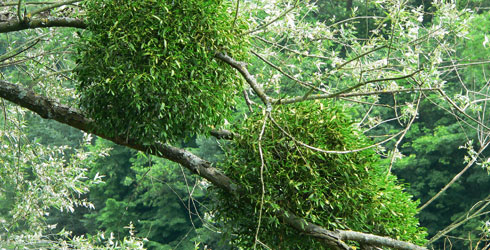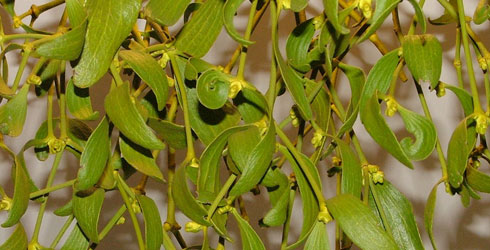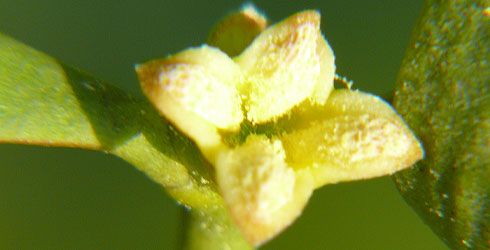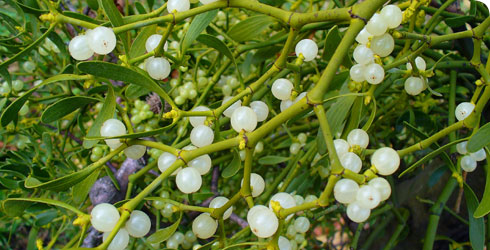Viscum album (mistletoe)
Mistletoe is a plant which steals some, but not all of its nutritional requirements from other plants - it is a hemi-parasite.
It is a small, leathery-leaved evergeen which forms a ball-shaped mass easily seen on the branches of deciduous host trees in winter.
Mistletoe appears in the myths of various cultures although its association with kissing is largely restricted to the English-speaking world.
Species detail
-

Taxonomy
Mistletoe belongs to the family Viscaceae, and to the genus Viscum, which contains approximately 450 species of parasitic plants. Read on to find out more, and discover how you can age a mistletoe plant.
-

Distribution
Mistletoe is native to temperate regions of the old world and grows on a wide variety of tree species. Find out where you might see it.
-

Biology
All mistletoes are parasitic on other plants, and rely on their hosts for most of their food. Discover how the plant gains a foothold on the host tree.
-

Uses
Kissing under the mistletoe has been a popular Christmas tradition in English-speaking nations since the 18th century, but its use in rituals goes back further. Find out more.
Images

Mistletoe forms a globular mass attached to the branch of the host tree.
© David Monniaux, Creative Commons Attribution-Share Alike 3.0 Unported
Viscum album - the leathery, yellowish green leaves are paired.

Each Viscum album berry contains a seed surrounded by sticky viscin.
© H Zell, Creative Commons Attribution-Share Alike 3.0 Unported
Viscum album - as the sticky viscin dries, it attaches the seeds to the branch.
© Bernd Haynold, Creative Commons Attribution-Share Alike 3.0 Unported
Viscum album flowers have 4 small, sepal-like petals.
© Rigolithe, Creative Commons Attribution-Share Alike 2.5 Generic
After germination, Viscum album seeds produce haustoria which penetrate the bark and connect with the host’s vascular system.
© Denis Michel, Creative Commons Attribution-Share Alike 2.5 GenericAuthor
Bob Press
Former Associate Keeper of Botany
Department of Botany
A word from the author
"Not only is mistletoe instantly recognisable because of its distinctive appearance, it has a fascinating parasitic lifestyle."

